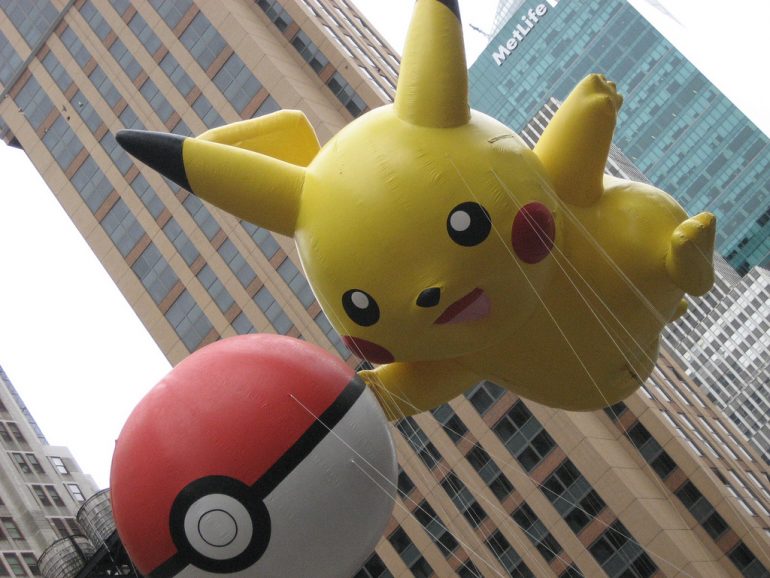“Without the fun, none of us would go on.” That sentiment certainly describes the motivation behind countless blundering, adventurous Pokémon Go fans who are crashing backyards, private shops, and stationary objects in search of their next augmented reality quarry visible on their smartphone.
It’s also a line attributed to Ivan Sutherland, a computer scientist who got into the field very early (so early, that few people playing the game today on their smartphones would visually correlate Sutherland’s clunky apparatus as computers). In the late 1960s, Sutherland’s Sword of Damocles was the cutting edge of VR and AR: it showed off wire-frame rooms through a head-mounted display so heavy that users were fastened into the headset, which was suspended from the ceiling.
“It’s fascinating how a mobile augmented reality game is catching on like it is now, since these games have actually been around for a long time,” said Bernard Riecke, a professor at Simon Fraser University School of Interactive Art and Technology professor and Space Lab Director.
“Vancouver has a pretty good virtual reality community and that’s where a lot can happen.” – Bernard Riecke
The first immersive displays and environments were more like individual fun rides, involving specialized sounds, shaking and other sensory effects. Today, we can achieve magical results with much lighter technology, but the inspiration for the current gaming craze has been a long time coming. “If you look at old patents from the 1960s, you can see something that looks like the Occulus Rift,” Riecke said. “It’s finally getting there.”
Carman Neustaedter, professor at Simon Fraser University and Director of the Connections Lab, adds that the timing of Pokémon Go’s release is very clever, in how it has generated appeal across generations. “It’s a game and an idea that relates to people in their 20s and 30s. At the time it came out in the ‘90s, they experienced it in TV and cartoons and card games.”
It allows users to revisit their childhoods at the same time that youth today is experiencing the Pokémon brand for the very first time. It’s like watching a movie that has jokes both for adults and kids. The game is exposing interesting social dynamics among people across generations, as kids play differently than adults did when they were young. But it’s also helping kids take up responsible, mature considerations of the technology they’re using. While Neustaedter was hunting Pokémon with his son this week, conversation between them quickly turned to how quickly the battery could drain, or how much data they might use while roaming.
Playing with new technology paradigms
While the ability of Pokémon Go’s simple AR functionality transfixes the masses, Riecke suggests we haven’t seen anything yet. “With Pokémon Go, you’re just doing this on a small screen. It’s the lowest form of augmented reality and really isn’t that immersive. You’re just overlaying objects from a camera.”
But it’s not going to stay that ‘primitive’ for long, Riecke suggests. We could be on the verge of experiencing truly immersive environments that can help us forge new experiences, navigate difficult decisions and even imagine what it would be like to live in alternate realities.
Can Canada be a nerve centre for new immersive realities?
“Vancouver has a pretty good virtual reality community and that’s where a lot can happen,” Riecke explains. “For Canada, there are a lot of opportunities for collaboration between companies, universities, and research centres. That’s not as easy to put together in other countries. For instance, we’ve already worked with some local gaming companies. As well, in Canada, it’s relatively easy to get kickstart funding, which creates even more opportunities.”
Canada’s multicultural landscape could also make it a launching point for new VR and AR ventures. “Some CEOs here have good ties to China – and if we can cover the English speaking and Chinese markets, that covers a good portion of the world market,” said Riecke.
A lot of the innovation for this technology will be driven by gaming companies – as well as porn studios, Riecke acknowledges. “A porn version of Pokémon Go is inevitable, if it’s not out there already. It could be already, but I wouldn’t even know where to look for it.”
The future of augmented reality is catching up with the past
Perhaps one day soon, a new game (or the next game in the Pokémon franchise) will take AR even further. As Sutherland explained long ago in his essay on The Ultimate Display, back in 1965: “The ultimate display would, of course, be a room within which the computer can control the existence of matter. A chair displayed in such a room would be good enough to sit in. Handcuffs displayed in such a room would be confining, and a bullet displayed in such a room would be fatal. With appropriate programming such a display could literally be the Wonderland into which Alice walked.”
When will we can finally capture that level of immersive AR experience? Time will tell.


